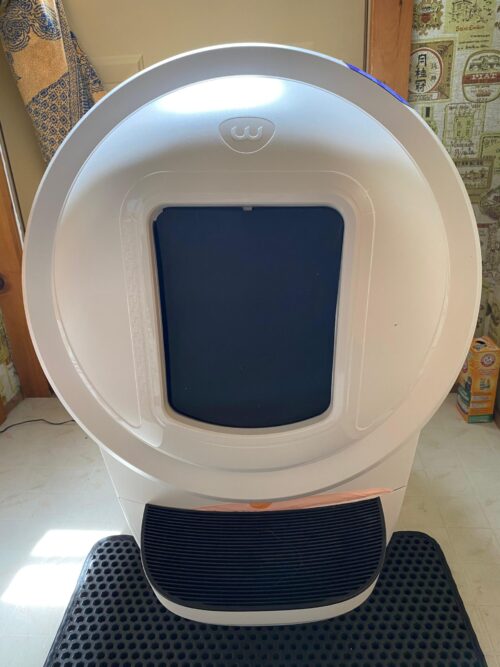
I used the Litter-Robot 4 Shield for a few weeks with my cat Sophie, who is naturally shy and sensitive to changes. She did use the litter box with the Shield installed — but only without the flap. I knew from the start that the flap would be too much for her, so I left it off.
Although I eventually had to remove the Shield to keep Sophie fully comfortable, during those weeks I tested how well it actually works to contain kicked litter and even accidental liquid messes. I ran my own simulations to see how far it could hold back splashes and where its limits were. In this review, I’ll share what I discovered — how it performed, what most reviews overlook, and which types of cats and homes it’s truly best for.
What Is the Litter-Robot 4 Shield?
The Shield is an optional accessory for the Litter-Robot 4. It attaches around the entry of the globe to help:
- Contain kicked litter
- Reduce tracking
- Provide more privacy for the cat
It includes a sturdy plastic frame, a rubber flap that hangs over the entry, and a hinge to install the ramp if you use one. It’s compatible with or without the ramp and is marketed as easy to install.
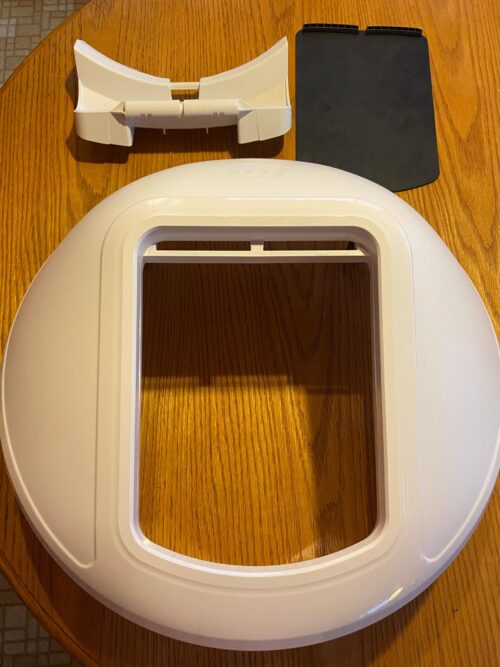
What the Shield Is Designed to Do:
- Contain kicked litter inside the globe
- Minimize scatter around the entry
- Reduce litter tracking across floors
- Increase privacy for shy or nervous cats
- Potentially block urine spray near the front entry
- Deter front-facing urination with the flap
- Improve the look of the Litter-Robot 4 setup
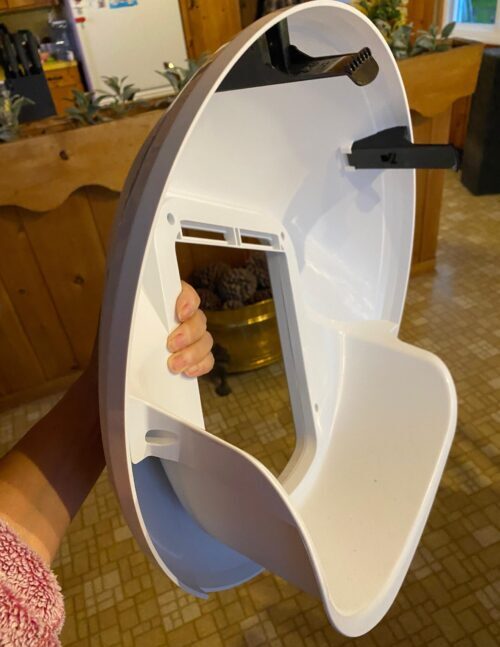
My Setup and Testing Conditions
- Litter used: Tidy Cats Free & Clean Unscented
- Shield installed without the flap
- Ramp attached
- Cat Profile: My cat Sophie, a shy adult cat, 7.0–7.5 lbs
- Duration: used a few times over roughly a week
Sophie used the litter box for a few days with the Shield on, but she was clearly uncomfortable from the beginning. I had to encourage her with treats, and while she did use it, I could tell she didn’t love the more enclosed feel. Here’s a short clip of that moment — you can see her getting partway in while I encouraged her with treats:
Why I Removed the Shield (Even Though It Works)
Sophie never looked fully comfortable using the Shield. While she tolerated it for several uses, she was hesitant, and after a few days, began avoiding the box altogether. She prefers open visibility and is used to seeing directly into the litter bed from a wide entry.
I never attempted to leave the flap installed while she was using it. I did try attaching it to see how it worked, but Sophie immediately reacted like, “What are you doing?” I knew she wouldn’t go in. That said, the Shield clearly works. I tested it myself and found it helpful in more ways than I expected.
Litter Containment: Visible Results
Sophie normally kicks litter toward the ramp and especially to the left side, where it falls between the mat and the floor. Since she doesn’t walk out via the ramp, this usually causes extra scatter.
With the Shield installed, the difference was significant. It didn’t keep the area spotless, but the reduction in scatter was clear. I could go a couple of days without sweeping, and the litter mat stayed much cleaner.

Liquid Containment: Surprisingly Effective (to a Point)
Using a syringe filled with lukewarm water, I sprayed from inside the globe toward the inner lower portion of the Shield. The water was contained and slid down into the litter bed as intended.
There is a seam between the bezel and the Shield that could leak if a cat sprays toward the upper entry walls. But as long as urine hits below that seam, the Shield can help redirect it downward. In my test, the Shield held water well when sprayed below the seam. That seam begins approximately 11 inches above the surface of the litter bed. If a cat sprays higher than that point, liquid could potentially leak through the gap.
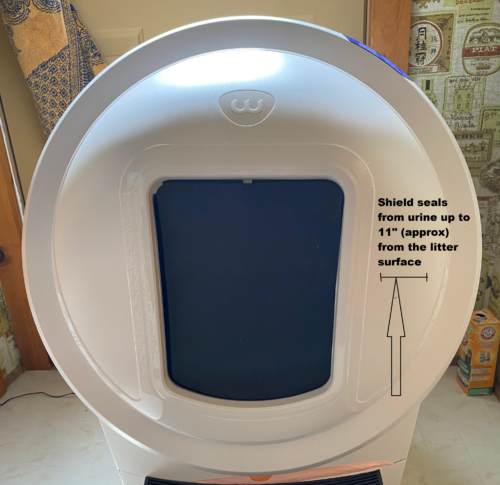
If your cat tends to urinate near the front, this is an important containment advantage. Here’s a screenshot on how the shield works to contain liquids (full video with testing at the end of the article).
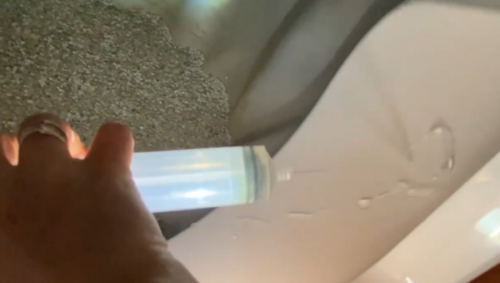
Flap Impact: For Some Cats, Not All
Sophie isn’t used to flaps or enclosed litter boxes. She prefers open entry where she can see the inside of the globe. The added structure of the Shield, even without the flap, was already a stretch for her.
But for cats who are used to flaps (like those who use covered litter boxes or cat doors), the Shield may feel natural and even comforting. The flap itself is soft, flexible, and likely to serve as a visual and physical deterrent. If a cat feels the rubber touch its back end, it may instinctively turn around before spraying toward the entrance.
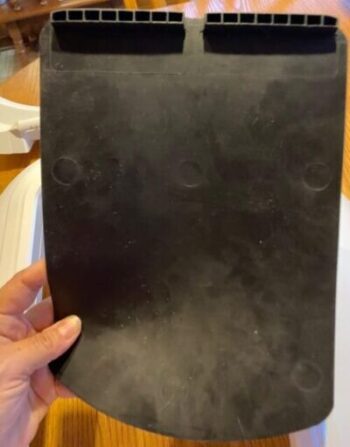
Installation, Fit, and Compatibility
Installation is quick (under 5 minutes, check my video on YouTube here), but requires care. One thing to watch for during installation: it might seem secure when it’s not fully clicked into place. Make sure it seals tightly so that there’s no visible gap between the Shield and the bezel — otherwise, the gap will let litter or urine leak.
The Shield fits securely with the ramp and feels sturdy. Sophie, at 7.0–7.5 lbs, fit comfortably through the opening, which measures about 9 inches tall and 7.5 inches wide.
My Shy Cat Testing the Litter-Robot 4 Shield
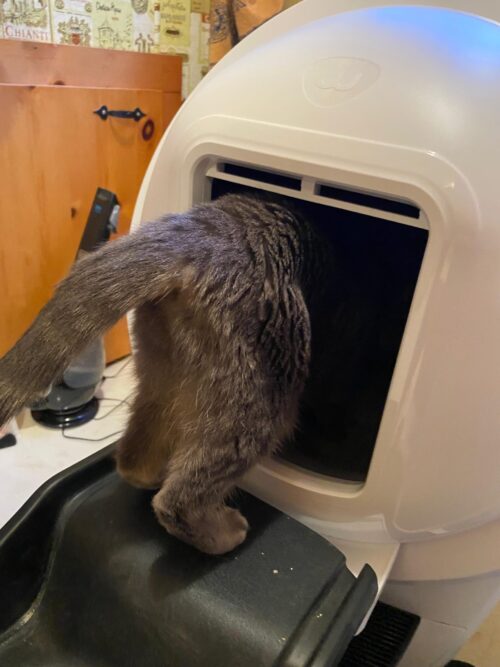
Cleaning and Maintenance
I wiped the Shield clean after use with a damp paper towel and a drop of Dawn soap. It rinsed easily and dried without residue. The surface collected some litter dust, but it was easy to remove.
I didn’t have to clean any urine since Sophie doesn’t pee toward the entry, but based on how the plastic handled water, it would likely resist odor if cleaned regularly. The flap material is just as easy to clean.
Durability and Materials
After usage I noticed no scratching, fading, or misalignment. The Shield plastic feels thick and strong, and the flap rubber is both soft and resilient.
At a Glance: Pros and Cons
| ✅ Pros | ⚠️ Cons |
|---|---|
| Significantly reduces litter scatter | Not suitable for shy or flap-sensitive cats |
| Helps redirect urine toward litter bed | Seam can leak if cat sprays high |
| Easy to install and clean | Entry may feel restrictive for larger cats |
| Durable build, secure with ramp | |
| Flap may deter spraying for some cats |
Who Should Get the Shield?
| ✅ Best For | 🚫 Not Ideal For |
|---|---|
| Confident, adaptable cats | Shy or nervous cats |
| Cats used to flaps or enclosed spaces | Cats that avoid enclosed spaces |
| Homes struggling with scatter or front-aimed urine | Large breeds needing more clearance |
Frequently Asked Questions
Can I use the Shield without the flap?
Yes. I tested it that way, and it still worked very well.
Does it work with the ramp?
Yes. It fits securely and looks cohesive when installed with the ramp.
Does the flap help with smell?
Not noticeably, but it might slightly limit airflow from the entry.
Will it help with a spraying cat?
It can help direct low sprays downward, but it won’t stop high-aimed urine from leaking at the seam.
Final Verdict
The Shield is one of the latest Litter-Robot 4 accessories and a useful upgrade if your cat accepts it. It helps reduce mess, adds privacy, and enhances the overall look of the Litter-Robot 4 setup. If you’re exploring more upgrades, check out my full Litter-Robot 4 accessories reviews page where you can find all the current Litter Robot accessories that will help enhance your unit’s performance.
That said, it’s not for every cat. Sophie tolerated it for a short time, but ultimately preferred her open box. If your cat is confident, curious, or already used to flaps, this may be a great addition. Just test it flap-free first and watch your cat’s reaction. Get the Litter-Robot 4 Shield in Whisker official website 👉 here.
Watch My Full Video Review
If you’d like to see how I tested the Shield and what the liquid test looked like in real time, check out my full video review below.
Some content contains affiliate links or samples for reviews; I may receive compensation. Learn more
Leave a Reply